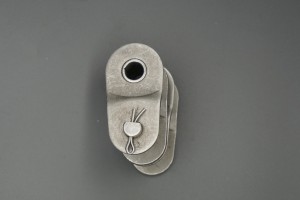Structural features of roller chain and connecting links
1. Structural features of roller chain
Roller chain is a type of chain widely used in mechanical transmission. Its structural features are as follows:
(I) Basic composition
The roller chain consists of inner link plates, outer link plates, pins, sleeves and rollers. The inner link plates and sleeves, the outer link plates and pins are interference fits, while the rollers and sleeves, and the sleeves and pins are clearance fits. This fit allows the chain to rotate flexibly during operation while maintaining structural stability.
(II) Chain plate design
The chain plates of roller chains are usually designed in an “8″ shape. This design can make the tensile strength of each cross section of the chain plate roughly the same, while reducing the weight of the chain and the inertia force during movement.
(III) Pitch
The pitch of the roller chain is one of its most important parameters. The larger the pitch, the larger the size of each component of the chain and the higher the load-bearing capacity. The size of the pitch directly affects the transmission performance and service life of the chain.
(IV) Multi-row chain
In order to meet greater load requirements, roller chains can be designed as multi-row chains. Multi-row chains are connected by long pins, and their load-bearing capacity is proportional to the number of rows. However, too many rows will lead to higher requirements for manufacturing and installation precision, and it is difficult to ensure the uniformity of force on each row, so the number of rows should not be too many.
2. Structural characteristics of connecting links
The connecting link is an important component of the roller chain, which is used to connect the two ends of the chain to form a closed ring chain. The structural characteristics of the connecting link are as follows:
(I) Connection method
There are usually two forms of connecting links: split pin fixation and spring card fixation. Split pin fixation is suitable for large pitch chains, while spring card fixation is suitable for small pitch chains.
(II) Transition link
When the total number of links in the chain is an odd number, a transition link is required to connect. The chain plate of the transition link will generate additional bending moment when it is pulled, so its strength is lower than that of the general link. In order to avoid the use of transition links, the number of links in the chain should be as even as possible during design.
(III) Composite transition link
The composite transition link is an improved transition link with a more complex structure than the ordinary transition link, but with better performance. The composite transition link can better bear the load and reduce the influence of the additional bending moment.
3. The coordination of roller chain and connecting link
The coordination of roller chain and connecting link is the key to ensure the performance of chain transmission. During the design and use process, the following points should be noted:
(I) Chain length
The length of the chain is usually expressed in the number of links. Generally, an even number of links is selected so that it can be fixed with a cotter pin or spring card. If the number of links is an odd number, a transition link must be used.
(II) Lubrication
In order to reduce the wear between the pin and the sleeve, the roller chain needs to be lubricated during operation. Good lubrication can extend the service life of the chain and improve the transmission efficiency.
(III) Maintenance
Regularly check the wear of the chain and replace the severely worn links in time. At the same time, pay attention to the tension of the chain to ensure that the chain will not loosen or jump teeth during operation.
4. Application and Advantages
(I) Application Field
Roller chains are widely used in mechanical transmission in various industries such as agriculture, mining, metallurgy, petrochemicals, and lifting and transportation. Its transmission power can reach 3600kW, the chain speed can reach 30~40m/s, and the maximum transmission ratio can reach 15.
(II) Advantages
High efficiency: The roller chain transmission efficiency is high, generally up to 96%~97%.
High load-bearing capacity: Roller chains can withstand large loads and are suitable for heavy-duty transmission.
Strong adaptability: Roller chains can work in harsh environments such as high temperature, dust, and humidity.
Compact structure: The roller chain transmission structure is compact and occupies little space.
5. Conclusion
The structural characteristics of roller chains and their connecting links make them widely used and have significant advantages in mechanical transmission. Through reasonable design and maintenance, roller chains can achieve efficient and reliable transmission to meet the needs of different industrial scenarios.
Post time: Jul-23-2025

